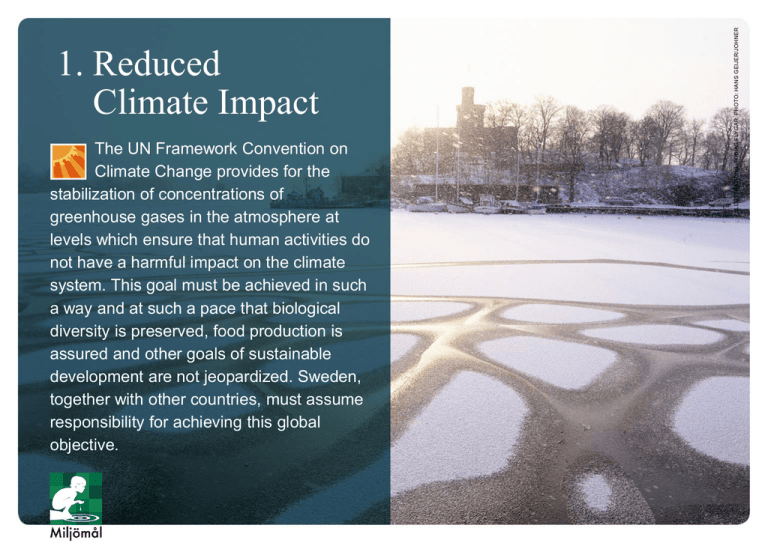Definition Environmental Objectives
advertisement

The UN Framework Convention on Climate Change provides for the stabilization of concentrations of greenhouse gases in the atmosphere at levels which ensure that human activities do not have a harmful impact on the climate system. This goal must be achieved in such a way and at such a pace that biological diversity is preserved, food production is assured and other goals of sustainable development are not jeopardized. Sweden, together with other countries, must assume responsibility for achieving this global objective. ILLUSTRATIONS: TOBIAS FLYGAR. PHOTO: HANS GEIJER/JOHNER 1. Reduced Climate Impact The air must be clean enough not to represent a risk to human health or to animals, plants or cultural assets. PHOTO: PEDER BJÖRKEGREN/JOHNER 2. Clean Air The acidifying effects of deposition and land use must not exceed the limits that can be tolerated by soil and water. In addition, deposition of acidifying substances must not increase the rate of corrosion of technical materials located in the ground, or water main systems, archaeological objects and rock carvings. PHOTO: HANS BJURLING/JOHNER 3. Natural Acidification Only The occurence of man-made or extracted compounds in the environment must not represent a threat to human health or biological diversity. Concentrations of non-naturally occuring substances will be close to zero and their impacts on human health and on ecosystems will be negligible. Concentrations of naturally occuring substances will be close to background levels. PHOTO: GÖRAN NYRÉN/JOHNER 4. A Non Toxic Environment The ozone layer must be replenished so as to provide long-term protection against harmful UV radiation. PHOTO: PER MAGNUS PERSSON/JOHNER 5. A Protective Ozone Layer Human health and biological diversity must be protected against the harmful effects of radiation. PHOTO: KENNETH BENGTSSON/JOHNER 6. A Safe Radiation Environment Nutrient levels in soil and water must not be such that they adversely affect human health, the conditions for biological diversity or the possibility of varied use of land and water. PHOTO: LENA KOLLER/JOHNER 7. Zero Eutrophication Lakes and watercourses must be ecologically sustainable and their variety of habitats must be preserved. Natural productive capacity, biological diversity, cultural heritage assets and the ecological and water-conserving function of the landscape must be preserved, at the same time as recreational assets are safeguarded. PHOTO: ANNIKA VANNERUS/JOHNER 8. Flourishing Lakes and Streams Groundwater must provide a safe and sustainable supply of drinking water and contribute to viable habitats for flora and fauna in lakes and watercourses. PHOTO: JEPPE WIKSTRÖM/JOHNER 9. Good Quality Groundwater The North Sea and the Baltic Sea must have a sustainable productive capacity, and biological diversity must be preserved. Coasts and archipelagos must be characterized by a high degree of biological diversity and a wealth of recreational, natural and cultural assets. Industry, recreation and other utilization of the seas, coasts and archipelagos must be compatible with the promotion of sustainable development. Particularly valuable areas must be protected against encroachment and other disturbance. PHOTO: JEPPE WIKSTRÖM/JOHNER 10. A Balanced Marine Environment, Flourishing Coastal Areas and Archipelagos The ecological and water- conserving function of wetlands in the landscape must be maintained and aluable wetlands preserved for the future. PHOTO: PÄR BRÄNNSTRÖM/JOHNER 11. Thriving Wetlands The value of forests and forest land for biological production must be protected, at the same time as biological diversity and cultural heritage and recreational assets are safeguarded. PHOTO: ULF HUETT NILSSON/JOHNER 12. Sustainable Forests The value of the farmed landscape and agricultural land for biological production and food production must be protected, at the same time as biological diversity and cultural heritage assets are preserved and strengthened. PHOTO: TORE HAGMAN/NATURFOTOGRAFERNA/PIXELFACTORY 13. A Varied Agricultural Landscape The pristine character of the mountain environment must be largely preserved, in terms of biological diversity, recreational value, and natural and cultural assets. Activities in mountain areas must respect these values and assets, with a view to promoting sustainable development. Particularly valuable areas must be protected from encroachment and other disturbance. PHOTO: HANS GEIJER/JOHNER 14. A Magnificent Mountain Landscape Cities, towns and other built-up areas must provide a good, healthy living environment and contribute to a good regional and global environment. Natural and cultural assets must be protected and developed. Buildings and amenities must be located and designed in accordance with sound environmental principles and in such a way as to promote sustainable management of land, water and other resources. PHOTO: GÖRAN ASSNER/JOHNER 15. A Good Built Environment Biological diversity must be preserved and used sustainably for the benefit of present and future generations. Species habitats and ecosystems and their functions and processes must be safeguarded. Species must be able to survive in long-term viable populations with sufficient genetic variation. Finally, people must have access to a good natural and cultural environment rich in biological diversity, as a basis for health, quality of life and well-being. PHOTO: KENNETH BENGTSSON/JOHNER 16. A Rich Diversity of Plant and Animal Life






